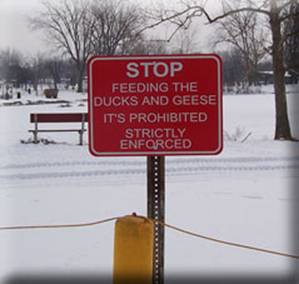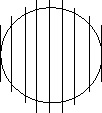Canada Geese Management
Introduction | Human & Habitat Modification | Abatement, Hunting & Permits | Questions & Answers
Urban areas are attractive places for geese because they prefer nicely groomed lawns adjacent to water. This preference, reduced predator rates, limited hunting, and feeding by residents result in waterfowl concerns in highly populated areas. Modification techniques can be implemented to mitigate conflicts. It is also suggested that urban planners and building contractors design projects with these habitat modifications in mind. It is generally easier and more economical to implement goose mitigation techniques prior to building a site than to change an existing site.
Do Not Feed Wildlife
Feeding waterfowl is a popular practice for many people,  but it is also a major reason why geese are attracted to certain areas and remain there for long periods of time which can exacerbate Canada goose problems. It concentrates larger numbers of geese in areas that under normal conditions would only support a few. Feeding can include intentional feeding as well as accidental feeding from things like overspill from birdfeeders and pet food.
but it is also a major reason why geese are attracted to certain areas and remain there for long periods of time which can exacerbate Canada goose problems. It concentrates larger numbers of geese in areas that under normal conditions would only support a few. Feeding can include intentional feeding as well as accidental feeding from things like overspill from birdfeeders and pet food.
Artificial feeding can also disrupt normal migration patterns and hold geese in areas longer than normal. With an abundant source of artificial food available, geese can devote more time to locating nesting sites and mating. Feeding waterfowl also increases the susceptibility to avian diseases, which have the potential to kill large numbers of geese and other waterfowl. Feeding waterfowl can make other forms of management ineffective. Finally, human food sources rarely provide proper nutrition for waterfowl and frequently do more harm than good.
Individuals and communities should consider adopting a “No Feeding Wildlife” policy. These policies are more successful if they are strictly enforced and if signage is posted showing clear consequences for feeding wildlife. Reducing food handouts by well-intentioned people should help make the area less attractive to waterfowl and other wildlife.
Barriers
- Vegetative Buffer Strips
Vegetative buffer strips can act as a physical barrier to deter geese from using shorelines next to bodies of water. Geese like gently rolling slopes with short vegetation at the water’s edge. It provides a clear line of site to avoid predators and provides easy access to water. Tall, thick vegetative buffer strips are typically comprised of native warm season grasses, wildflowers (forbs), trees, and/or shrubs.
Native warm season grasses and forbs remain tall and erect throughout the winter, making them an excellent choice for establishing buffer strips. For buffer strips to be effective, they must retain their mature height throughout the entire year. Therefore, any mowing of buffer strips will reduce their effectiveness and may render them useless as a goose deterrent.
Trees and shrubs may also be used for buffer strips. It is not recommended to establish trees or shrubs on dams or levees. A buffer strip used in conjunction with a suspended cable grid, described below, is particularly effective in deterring waterfowl from using a water body. Buffer strips should be at least 30 feet wide and 3 feet tall to be effective. Several different seeding mixtures can be used for buffer strips. A District Wildlife Biologist can also be contacted for further recommendations.
Using native vegetative buffers can reduce geese’s abilities to access water, re-establish native plants, and can provide habitat for other wildlife.
- Rock Barriers
Rock barriers consisting of boulders at least 2 feet in diameter can be placed along the shoreline. Geese normally like to walk out of the water on bare, flat, or gently sloping banks. The effectiveness of a rock barrier can be enhanced when used in combination with vegetative barriers. Rip rap and smaller rock around a pond will not deter geese. Rules and regulations need to be examined prior to placing rock barriers on any waterbody. Feeding geese will make rock barriers ineffective.
- Fence Barriers
Fence barriers will physically prevent geese from walking out of the water into feeding areas like turf grass. Fencing can consist of woven wire, wooden or plastic snow fencing, chicken wire, silt fencing, netting, mylar tape, or several strands of heavy fishing line or wire. If using line or wire it should be strung at intervals of 4, 8, 12, 18, and 24 inches above the ground. Make sure that the fence is long enough so the geese will not walk around the ends it.
Fence barriers are most effective if they are placed prior to the nesting season. When scouting for nesting locations, geese need to find areas that they can walk their goslings to the water when they hatch and when adults are molting. If a barrier is in place prior to nesting, it is more likely a mating pair will search elsewhere for a nesting location.
- Suspended Grid Systems
Creating a suspended grid system over water is a quick and cost-effective solution to deter waterfowl from inhabiting small waterbodies. Suspended grids create a barrier that physically prevents waterfowl from accessing water, making an area less attractive to geese. Supplies for creating a grid include brightly colored twine or rope, 10 to 28 gauge wire, or mylar tape and stakes or poles strong enough to support the weight and tension of grid. High visibility is key.
Place stakes or poles in 5-foot increments along one side of the waterbody and then repeat that process on the opposite side. Then connect the corresponding stakes or poles on each side of the waterbody with the twine, wire, or mylar tape. Once this is completed for the entire length of the water body, complete this same process in a perpendicular fashion along the remaining two sides of the water body (Figure 1). As the lines are stretched across the water body, they should reach a height of 12 to 30 feet off the water’s surface. Make sure to use bright colored materials so that the geese can see the grid.
Using environmentally friendly and weather resistant materials will provide long term benefits without compromising the environmental integrity of the water body.
Original Water Body

Step 1:
Stretch twine, wire, or mylar tape across the water body (5’ increments)
Step 2:
Stretch twine, wire, or mylar tape in
perpendicular fashion (5’ increments)
- Minimize Islands and Peninsulas
Islands and peninsulas are ideal nesting and resting sites for geese. These areas are surrounded by water and offer protection and security from predators. When creating new ponds, lakes, or retention basins, consider reducing islands and peninsulas. Elimination of existing islands and peninsulas after construction is expensive and difficult.
- Minimize Aerators and Fountains
Minimize open water during winter. Open water during winter attracts local and migrant geese. Geese are attracted to the spray associated with fountains and aerator systems which also keep water from freezing during winter. Consider shutting this off in winter.
- Other Habitat/Landscape Modifications
Goose nests are often localized near landscaping features, adjacent to doorways or windows, and along paths. In such localized instances, quick fix solutions and temporary barriers can be employed. Some solutions include:
- Reducing mulch in landscaping and replacing with lava rock
- Using snow fencing or chicken wire to block waterfowl from areas
- Using electric fencing to deter waterfowl from entering open areas
- Avoiding creating landscaping structures that resemble “nesting structures”
- Applying approved chemical repellents to lawns and grass areas, following label instructions
- Employing decoys of “would-be” predators to deter waterfowl.
